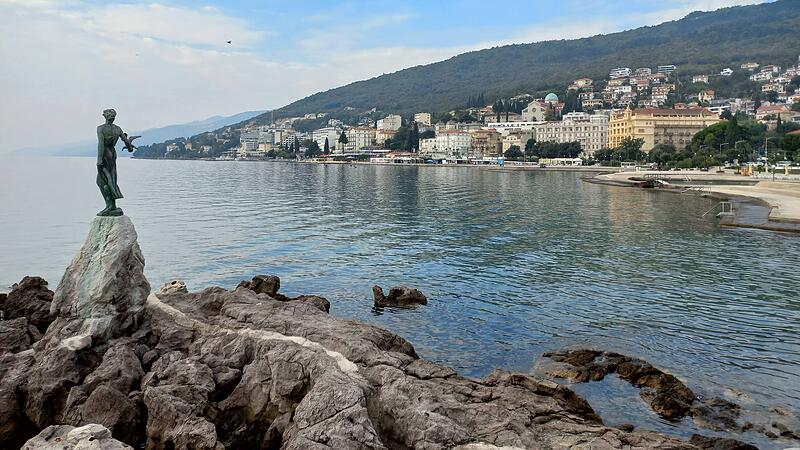The railway made a significant contribution to Opatija becoming one of the most fashionable health resorts on the old continent 150 years ago. Even today, the charming little town on the Kvarner Bay is once again attracting crowds of guests – and they can arrive in the old saloon train, just like in the early days. Together with Moser Reisen, OÖ Nachrichten offers its readers an exclusive short holiday in the Croatian spring.
In 1873 the Vienna–Trieste southern railway line was extended with a branch line to Rijeka on the Kvarner Bay. The daily express steam train had to puff for 13 hours before it reached the “Winter Garden of Vienna”. On board the Austrian nobility, right up to the representatives of the imperial family, and the nouveau riche of the Wilhelminian era. The cultural elite also frequented the salons: from Franz Lehar to Gustav Mahler, from ballerina Isadora Duncan to Giacomo Puccini.
The girl with the seagull
By the way: Even today, a train journey takes longer than ten hours. In 1884, the Southern Railway Company, which was supposed to develop tourism alongside rail transport, had the first luxury hotel, the Kvarner, built in Opatija. At that time it was a fishing village, still called Abbazia because of the Italian (Venetian) influences. This means, like the Croatian word Opatija, abbey, because various orders had led monasteries here since the 15th century. The church of St. Jacob on the sea shore still reminds of this time. Today the churchyard is a tranquil square shaded by old trees in the middle of a tourism hotspot. The symbol of this coast, the girl with the seagull, stands on a rocky outcrop nearby. It is a statue that was only erected in 1956, but which also commemorates the Austro-Hungarian era, namely the bathing death of aristocratic guests.


Love nest of the monarchy
In the fin de siècle, the Austrian upper class came mainly from late autumn to spring. “It was cold and boring in Austria. It was 14 degrees here even in winter, and there was something going on. Abbazia was the love nest of the monarchy,” says tour guide Marija. “The aristocracy and the upper bourgeoisie didn’t stay for a few days like guests do today, but for weeks and months.”
What is the attraction of the old spa on the Adriatic today, the “old lady”, as Marija calls her? It is the blend of year-round friendly climate and old Imperial and Royal charm. The offshore islands of Krk and Cres protect the coastal towns from the worst winds, a mountain range with the 1400 meter high Monte Maggiore or Ucka not only invites you to hike, but also shields the coastal towns from the unfriendly north-west weather.
“The camellia is the symbol of our climate because it thrives outdoors all year round,” says Marija. The twelve kilometer long beach promenade, called Lungomare, from Lovran via Opatija to Volosko, is not only lined with mighty laurel trees and tamarisks, palm trees and cypresses, but also with villas and hotels from before the First World War.
The taste of the coast
The hotels on offer today are determined by the bed castles from Tito’s time, which have been modernized at great expense, mostly enriched with wellness facilities. The souvenir shops are full of modern knick knacks – and postcards with Imperial and Royal motifs.


The gastronomic offer is rich, whether in the restaurant or in the tavern, unfortunately also loaded with international dishes, from burgers to French fries. It gets really exciting with regional dishes: from spicy ham (Prsut) to the variety of sea creatures. The local wines complete the enjoyment: Malvazija (early red Veltliner), Grasevina (Welschriesling) or the elegant Zlatina from the island of Krk. The red from the autochthonous Teran vine is strong. The locals are particularly proud of two things: their olive oil and their truffles.
In the mountains and on the islands
A stay in Opatija tempts you to make a detour to the nice neighboring towns of Lovran, Moscenicka Draga, Icici or Volosko. Our travel offer also includes excursions to the island of Krk or inland, with mountains, gorges, old towns and historical peculiarities – such as the Glagolitic script.
A pearl is the once dirty mining town of Labin high above the Kvarner Bay. Coal mining stopped in 1989 and the historic city center has shone ever since. “Today, Labin is a town of artists, not of coal,” says the guide. Noble baroque houses line the streets. The view of the sea opens up from the terraces.


Hum, located just behind the Ucka Mountains, is advertised as the smallest town in the world. There is a city wall, a city gate, a church and the authorities (team) necessary for a city – but only 53 inhabitants. A jewel is the Romanesque cemetery church; 1000-year-old frescoes have been uncovered, some by the Master of Beran, painted with paint from the red earth that characterizes this area. Nearby are stone monuments depicting the letters of the Glagolitic script. With this we dive into a mystical time when Cyril of Salonika, known as the Apostle of the Slavs, developed characters that should better reflect the language of the people in the Balkans in order to make the Bible easier to understand. While the Cyrillic script survived, Glagoliza was gradually supplanted by Latin; the faithful oriented themselves more closely to the Roman Catholic Church than to the Byzantine Orthodox Church. Today the Glagolitic experiences a transfiguration; it no longer has any meaning for everyday life.
Krk is 3000 years old
You can delve even deeper into history on the island of Krk in the Kvarner Bay. The town of Krk itself is 3000 years old; the harbor entrance is dominated by the fortress of the Frankopan – a noble family that left its mark on the mainland from 1100 to 1671. The Frankopan owned around 300 castles and palaces on the coast and in the hinterland. These are now to be networked for tourism (frankopani.eu). An interesting hiking offer should also appeal to tourists: a Way of St. James around the island (caminokrk.com).


20 percent of Croatia’s gross domestic product is now achieved in tourism, more than in any other EU country. The population has fallen to 3.8 million since the restart in 1991; around 700,000 Croats have emigrated to the EU. After two painful years with Corona, a spirit of optimism has returned. There is a lot of life on the Kvarner Bay. A trip to nearby Rijeka proves that. The port city has many historical buildings in the center, in addition to concrete monsters from the Yugoslav era. In the National Theater there is a ceiling painting by Gustav Klimt. The old, very busy market halls are attractive.
Unlike in the Imperial and Royal period, most guests no longer come in winter, they want to enjoy the summer. There is no real beach in Opatija. Because of the limited space between the sea and the mountain, all the buildings reach right up to the waterline. The sea basins can only be reached via stairs or ladders. If you want a wide pebble beach, you have to drive a few kilometers to the south.
But the sunrise in Opatija completely makes up for it, says Marija, before recording the song of the same name by Croatia’s most famous ballet singer, Ivo Robic.
Arrival in the nostalgic train
It travels sublimely in the plush, carpet and varnish world of yesteryear. With his Viennese company “B&B Blue Train”, Christian Brenner mobilized half a dozen old saloon wagons from the interwar and post-war period and also adapted them a little to modern requirements. The historical ambience is still unbroken.


It takes around ten hours from Linz because scheduled trains have priority and longer stops are sometimes necessary. However, time flies by. The open cars allow for casual conversation, entertainment will be provided, refreshments and food will be served. In addition, the second central experience is the attractive, diverse landscape. The highlights are initially the Gastein, Möll and Drau valleys, later the Sava valley to Laibach and then up to Postojna (Adelsberg) and over the karst down to the Kvarner Bay to Rijeka.
Either the arrival or the departure takes place in the nostalgic train. Coaches are available for the other journey.
The train journey in detail
Included services: The five-day trip to the Opatija Riviera costs EUR 799 (early bird price until December 22nd) or EUR 859. The price includes travel (from Linz or Graz) by nostalgic train, bus rides, excursions, overnight stays in a 4-star hotel with half board, a typical local snack with wine and music, and German-speaking travel companions. The trip can also be done in reverse order: bus there – nostalgic train back.
Trips: An optional day trip to the coastal towns of Pula and Rovinj (59 euros) or to the island of Krk can be added to the trip to the Opatija Riviera according to the program
(45 euros) can be booked.
Meeting: March 30 to April 3, 2023
Contact details: The trip on the nostalgie train can be booked at Moser Reisen in Linz, Graben 18, password: nostalgie train, telephone 0732 2240-50 (9 a.m. – 1 p.m.), nostalgiezug@moser.at
Source: Nachrichten




